Professional Identity
VerifiedAdded on 2022/12/05
|8
|2158
|257
AI Summary
This article discusses the concept of professional identity in nursing and the importance of adhering to ethical standards. It explores the impact of neglect of duty and the need for person-centered care in providing safe and quality care to elderly residents. The article also highlights the role of colleagues in reporting concerns and the potential consequences for the nurse involved.
Contribute Materials
Your contribution can guide someone’s learning journey. Share your
documents today.
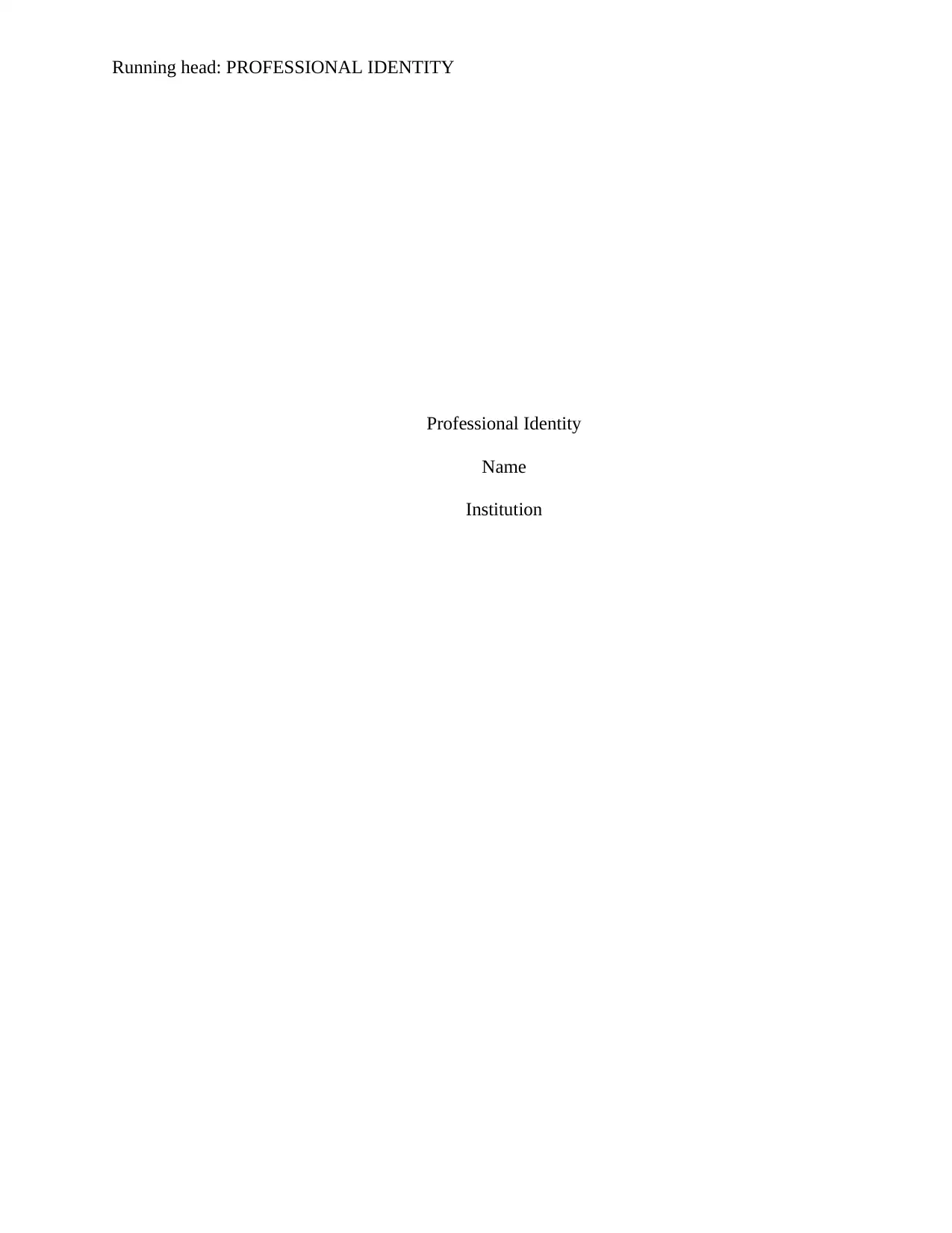
Running head: PROFESSIONAL IDENTITY
Professional Identity
Name
Institution
Professional Identity
Name
Institution
Secure Best Marks with AI Grader
Need help grading? Try our AI Grader for instant feedback on your assignments.
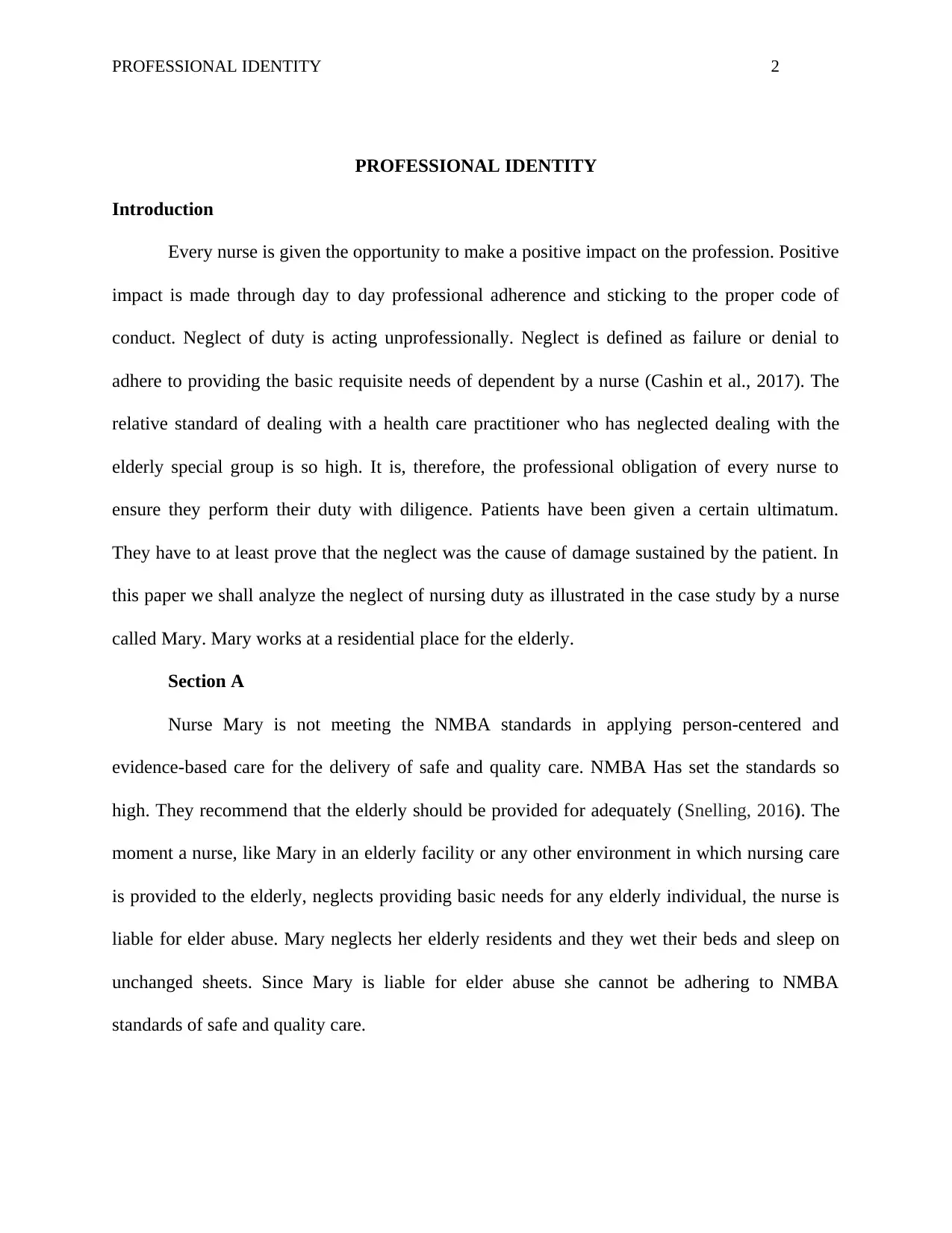
PROFESSIONAL IDENTITY 2
PROFESSIONAL IDENTITY
Introduction
Every nurse is given the opportunity to make a positive impact on the profession. Positive
impact is made through day to day professional adherence and sticking to the proper code of
conduct. Neglect of duty is acting unprofessionally. Neglect is defined as failure or denial to
adhere to providing the basic requisite needs of dependent by a nurse (Cashin et al., 2017). The
relative standard of dealing with a health care practitioner who has neglected dealing with the
elderly special group is so high. It is, therefore, the professional obligation of every nurse to
ensure they perform their duty with diligence. Patients have been given a certain ultimatum.
They have to at least prove that the neglect was the cause of damage sustained by the patient. In
this paper we shall analyze the neglect of nursing duty as illustrated in the case study by a nurse
called Mary. Mary works at a residential place for the elderly.
Section A
Nurse Mary is not meeting the NMBA standards in applying person-centered and
evidence-based care for the delivery of safe and quality care. NMBA Has set the standards so
high. They recommend that the elderly should be provided for adequately (Snelling, 2016). The
moment a nurse, like Mary in an elderly facility or any other environment in which nursing care
is provided to the elderly, neglects providing basic needs for any elderly individual, the nurse is
liable for elder abuse. Mary neglects her elderly residents and they wet their beds and sleep on
unchanged sheets. Since Mary is liable for elder abuse she cannot be adhering to NMBA
standards of safe and quality care.
PROFESSIONAL IDENTITY
Introduction
Every nurse is given the opportunity to make a positive impact on the profession. Positive
impact is made through day to day professional adherence and sticking to the proper code of
conduct. Neglect of duty is acting unprofessionally. Neglect is defined as failure or denial to
adhere to providing the basic requisite needs of dependent by a nurse (Cashin et al., 2017). The
relative standard of dealing with a health care practitioner who has neglected dealing with the
elderly special group is so high. It is, therefore, the professional obligation of every nurse to
ensure they perform their duty with diligence. Patients have been given a certain ultimatum.
They have to at least prove that the neglect was the cause of damage sustained by the patient. In
this paper we shall analyze the neglect of nursing duty as illustrated in the case study by a nurse
called Mary. Mary works at a residential place for the elderly.
Section A
Nurse Mary is not meeting the NMBA standards in applying person-centered and
evidence-based care for the delivery of safe and quality care. NMBA Has set the standards so
high. They recommend that the elderly should be provided for adequately (Snelling, 2016). The
moment a nurse, like Mary in an elderly facility or any other environment in which nursing care
is provided to the elderly, neglects providing basic needs for any elderly individual, the nurse is
liable for elder abuse. Mary neglects her elderly residents and they wet their beds and sleep on
unchanged sheets. Since Mary is liable for elder abuse she cannot be adhering to NMBA
standards of safe and quality care.
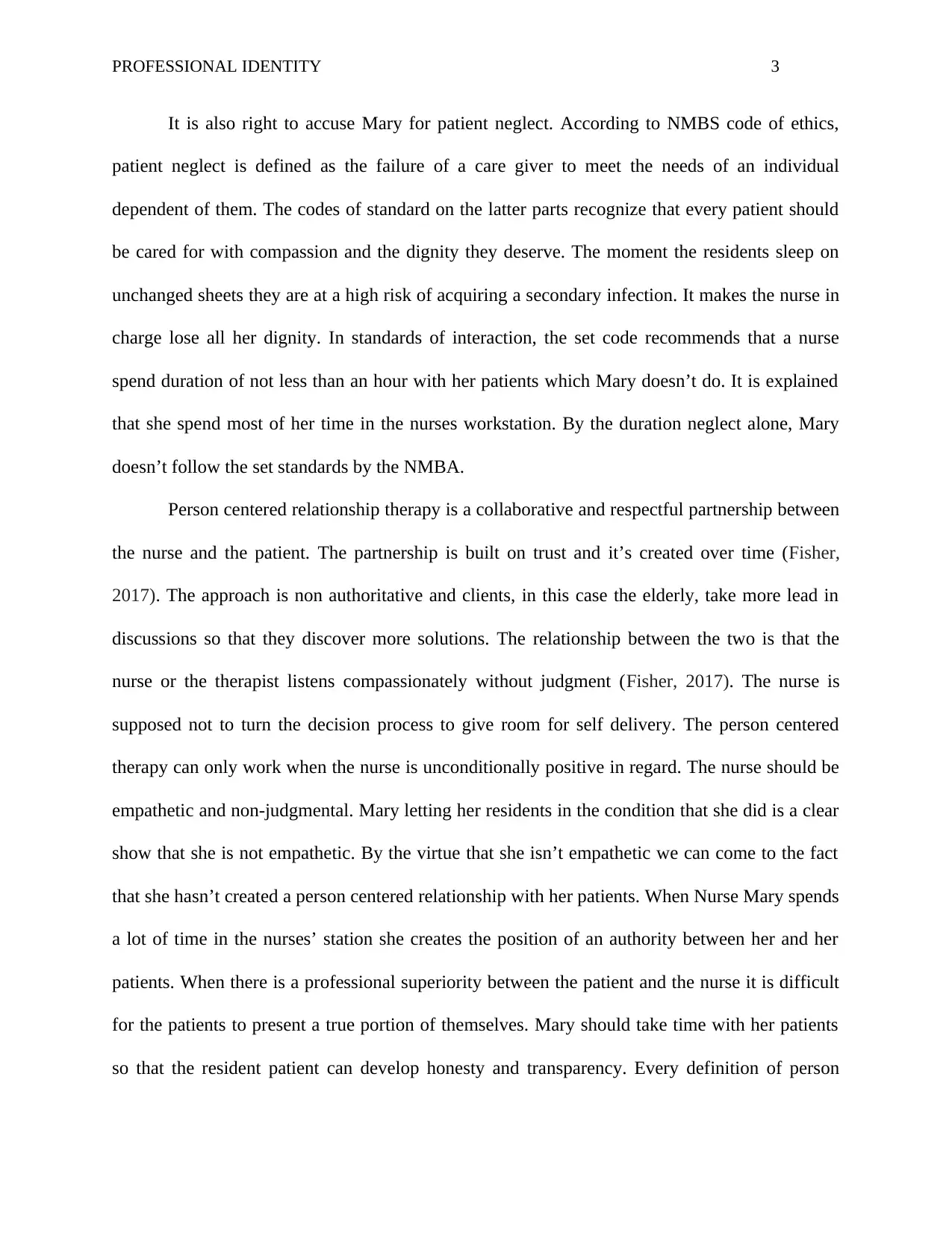
PROFESSIONAL IDENTITY 3
It is also right to accuse Mary for patient neglect. According to NMBS code of ethics,
patient neglect is defined as the failure of a care giver to meet the needs of an individual
dependent of them. The codes of standard on the latter parts recognize that every patient should
be cared for with compassion and the dignity they deserve. The moment the residents sleep on
unchanged sheets they are at a high risk of acquiring a secondary infection. It makes the nurse in
charge lose all her dignity. In standards of interaction, the set code recommends that a nurse
spend duration of not less than an hour with her patients which Mary doesn’t do. It is explained
that she spend most of her time in the nurses workstation. By the duration neglect alone, Mary
doesn’t follow the set standards by the NMBA.
Person centered relationship therapy is a collaborative and respectful partnership between
the nurse and the patient. The partnership is built on trust and it’s created over time (Fisher,
2017). The approach is non authoritative and clients, in this case the elderly, take more lead in
discussions so that they discover more solutions. The relationship between the two is that the
nurse or the therapist listens compassionately without judgment (Fisher, 2017). The nurse is
supposed not to turn the decision process to give room for self delivery. The person centered
therapy can only work when the nurse is unconditionally positive in regard. The nurse should be
empathetic and non-judgmental. Mary letting her residents in the condition that she did is a clear
show that she is not empathetic. By the virtue that she isn’t empathetic we can come to the fact
that she hasn’t created a person centered relationship with her patients. When Nurse Mary spends
a lot of time in the nurses’ station she creates the position of an authority between her and her
patients. When there is a professional superiority between the patient and the nurse it is difficult
for the patients to present a true portion of themselves. Mary should take time with her patients
so that the resident patient can develop honesty and transparency. Every definition of person
It is also right to accuse Mary for patient neglect. According to NMBS code of ethics,
patient neglect is defined as the failure of a care giver to meet the needs of an individual
dependent of them. The codes of standard on the latter parts recognize that every patient should
be cared for with compassion and the dignity they deserve. The moment the residents sleep on
unchanged sheets they are at a high risk of acquiring a secondary infection. It makes the nurse in
charge lose all her dignity. In standards of interaction, the set code recommends that a nurse
spend duration of not less than an hour with her patients which Mary doesn’t do. It is explained
that she spend most of her time in the nurses workstation. By the duration neglect alone, Mary
doesn’t follow the set standards by the NMBA.
Person centered relationship therapy is a collaborative and respectful partnership between
the nurse and the patient. The partnership is built on trust and it’s created over time (Fisher,
2017). The approach is non authoritative and clients, in this case the elderly, take more lead in
discussions so that they discover more solutions. The relationship between the two is that the
nurse or the therapist listens compassionately without judgment (Fisher, 2017). The nurse is
supposed not to turn the decision process to give room for self delivery. The person centered
therapy can only work when the nurse is unconditionally positive in regard. The nurse should be
empathetic and non-judgmental. Mary letting her residents in the condition that she did is a clear
show that she is not empathetic. By the virtue that she isn’t empathetic we can come to the fact
that she hasn’t created a person centered relationship with her patients. When Nurse Mary spends
a lot of time in the nurses’ station she creates the position of an authority between her and her
patients. When there is a professional superiority between the patient and the nurse it is difficult
for the patients to present a true portion of themselves. Mary should take time with her patients
so that the resident patient can develop honesty and transparency. Every definition of person
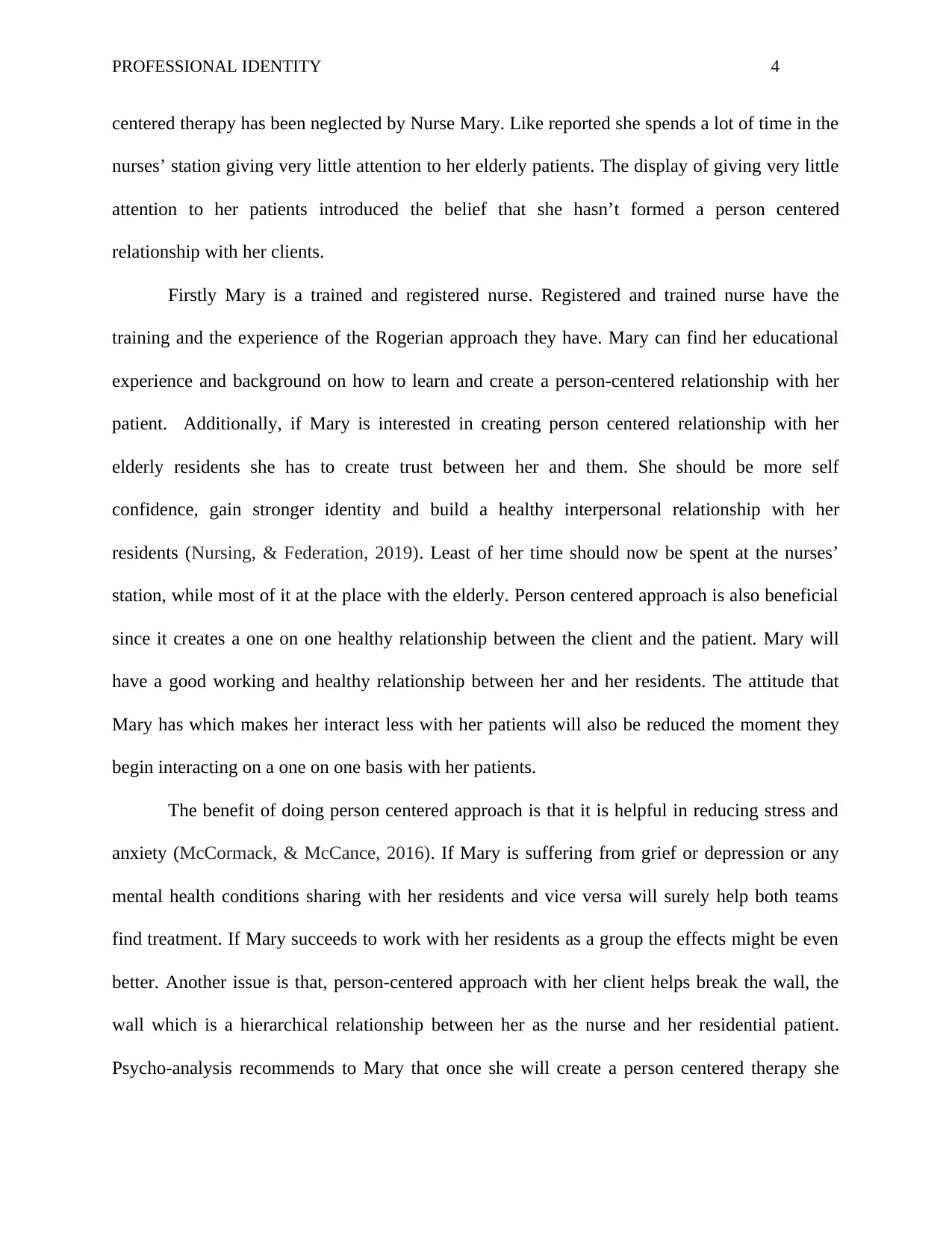
PROFESSIONAL IDENTITY 4
centered therapy has been neglected by Nurse Mary. Like reported she spends a lot of time in the
nurses’ station giving very little attention to her elderly patients. The display of giving very little
attention to her patients introduced the belief that she hasn’t formed a person centered
relationship with her clients.
Firstly Mary is a trained and registered nurse. Registered and trained nurse have the
training and the experience of the Rogerian approach they have. Mary can find her educational
experience and background on how to learn and create a person-centered relationship with her
patient. Additionally, if Mary is interested in creating person centered relationship with her
elderly residents she has to create trust between her and them. She should be more self
confidence, gain stronger identity and build a healthy interpersonal relationship with her
residents (Nursing, & Federation, 2019). Least of her time should now be spent at the nurses’
station, while most of it at the place with the elderly. Person centered approach is also beneficial
since it creates a one on one healthy relationship between the client and the patient. Mary will
have a good working and healthy relationship between her and her residents. The attitude that
Mary has which makes her interact less with her patients will also be reduced the moment they
begin interacting on a one on one basis with her patients.
The benefit of doing person centered approach is that it is helpful in reducing stress and
anxiety (McCormack, & McCance, 2016). If Mary is suffering from grief or depression or any
mental health conditions sharing with her residents and vice versa will surely help both teams
find treatment. If Mary succeeds to work with her residents as a group the effects might be even
better. Another issue is that, person-centered approach with her client helps break the wall, the
wall which is a hierarchical relationship between her as the nurse and her residential patient.
Psycho-analysis recommends to Mary that once she will create a person centered therapy she
centered therapy has been neglected by Nurse Mary. Like reported she spends a lot of time in the
nurses’ station giving very little attention to her elderly patients. The display of giving very little
attention to her patients introduced the belief that she hasn’t formed a person centered
relationship with her clients.
Firstly Mary is a trained and registered nurse. Registered and trained nurse have the
training and the experience of the Rogerian approach they have. Mary can find her educational
experience and background on how to learn and create a person-centered relationship with her
patient. Additionally, if Mary is interested in creating person centered relationship with her
elderly residents she has to create trust between her and them. She should be more self
confidence, gain stronger identity and build a healthy interpersonal relationship with her
residents (Nursing, & Federation, 2019). Least of her time should now be spent at the nurses’
station, while most of it at the place with the elderly. Person centered approach is also beneficial
since it creates a one on one healthy relationship between the client and the patient. Mary will
have a good working and healthy relationship between her and her residents. The attitude that
Mary has which makes her interact less with her patients will also be reduced the moment they
begin interacting on a one on one basis with her patients.
The benefit of doing person centered approach is that it is helpful in reducing stress and
anxiety (McCormack, & McCance, 2016). If Mary is suffering from grief or depression or any
mental health conditions sharing with her residents and vice versa will surely help both teams
find treatment. If Mary succeeds to work with her residents as a group the effects might be even
better. Another issue is that, person-centered approach with her client helps break the wall, the
wall which is a hierarchical relationship between her as the nurse and her residential patient.
Psycho-analysis recommends to Mary that once she will create a person centered therapy she
Secure Best Marks with AI Grader
Need help grading? Try our AI Grader for instant feedback on your assignments.

PROFESSIONAL IDENTITY 5
have known her patients on personal notes. Knowing her residents on personal notes will make
her potentially competent. As soon as she will initiate the move she will come more competent.
Section B
It is very right and logical for Mary’s peers to get worried and report the issue to their
supervisor. According to NMBA code of conduct a colleagues’ well being is important just as
your well being. The code recommends reporting of colleagues at the slightest suspicion. It is
mandatory that if a nurse suspects that a colleague is having a health condition, impairment or
neglecting duty in a way that it adversely affects the safety of other people or put them at risk
they should raise an alarm immediately. For the purpose of safety of the elderly residents under
Mary’s watch, the move to report her was justified. The residents were at risk of getting
infections which was absolutely not right. It would have been an ethical and conduct issue had
they refused to report Mary to the supervisor. Reporting Mary to the supervisor is also supported
in the Canadian nurse coding which warns the other nurses too. The code explains that: when a
judge is supposed to exercise professional judgment and doesn’t address it, she is capable of
being accused of neglect. Any nurse who observes a condition to be addressed should do so
almost immediately. If they are afraid to mention it to the manager, they should raise it to other
caregivers. Or better enough they should have personally consulted Mary as a care giver. It
should be noted that any ignorance on that part of her peers would have led to more trouble, as
they would also be accused of neglect of duty.
In dealing with Mary’s conduct it becomes quite complicated but the process is quite
clear. Firstly, the manager should facilitate investigations that define reason for such
irresponsible behavior (Haydon, Browne, & van der Riet, 2018). When the investigation is
ongoing Mary can be switched to a new station. If the neglect is on the part of Mary then legal
have known her patients on personal notes. Knowing her residents on personal notes will make
her potentially competent. As soon as she will initiate the move she will come more competent.
Section B
It is very right and logical for Mary’s peers to get worried and report the issue to their
supervisor. According to NMBA code of conduct a colleagues’ well being is important just as
your well being. The code recommends reporting of colleagues at the slightest suspicion. It is
mandatory that if a nurse suspects that a colleague is having a health condition, impairment or
neglecting duty in a way that it adversely affects the safety of other people or put them at risk
they should raise an alarm immediately. For the purpose of safety of the elderly residents under
Mary’s watch, the move to report her was justified. The residents were at risk of getting
infections which was absolutely not right. It would have been an ethical and conduct issue had
they refused to report Mary to the supervisor. Reporting Mary to the supervisor is also supported
in the Canadian nurse coding which warns the other nurses too. The code explains that: when a
judge is supposed to exercise professional judgment and doesn’t address it, she is capable of
being accused of neglect. Any nurse who observes a condition to be addressed should do so
almost immediately. If they are afraid to mention it to the manager, they should raise it to other
caregivers. Or better enough they should have personally consulted Mary as a care giver. It
should be noted that any ignorance on that part of her peers would have led to more trouble, as
they would also be accused of neglect of duty.
In dealing with Mary’s conduct it becomes quite complicated but the process is quite
clear. Firstly, the manager should facilitate investigations that define reason for such
irresponsible behavior (Haydon, Browne, & van der Riet, 2018). When the investigation is
ongoing Mary can be switched to a new station. If the neglect is on the part of Mary then legal

PROFESSIONAL IDENTITY 6
principles should be taken against her since she put her residents at risk. If the neglect is due to
organizational factors the manager should start thinking about changing the station at once
(Haydon, Browne, & van der Riet, 2018). The hospital of the agency that Mary works for might
be liable for any damages that the elderly shall have passed. If there is a manager, the moment
there is damage, the manager is also likely to be liable. The actions of Mary might lead the
company thinking of another better option who is not Mary. If Mary was working as an
independent physician she could be liable for her actions. However, since she is working under a
management which is caring for the elders, it is difficult to neglect her actions. More intently is
that the case hasn’t focused on whether Mary was suffering from anything psychologically. It
also doesn’t mention whether there existed acute damages to her residents. These two factors are
very crucial in concluding whether the actions of Mary were neglect of duty. In case there are
damages to her residents and it is neglect of duty, then legal and lawful actions will be taken
against her. However, since it doesn’t look like it, it can be cruel to choose legal actions against
her.
Conclusion
The code of conduct for nurses provides a perfect solution for solving cases of neglect of
duty. The NMBA undertakes all the functional conduct and document the rules so that it is easier
to implement them. The elderly are supposed to be provided for food, immediate healthcare
needs and protection. All these should be done by a nurse who treats them as vulnerable
individuals. In the case study Mary has surely failed. The paper has proved her failure using her
NMBA code. The set standard looks so high so that some nurses are failing to achieve them. The
professional identity of Mary is questionable. The paper has proved this in the following three
ways. One way is through showing Mary’s neglect of duty to the elderly residents she is
principles should be taken against her since she put her residents at risk. If the neglect is due to
organizational factors the manager should start thinking about changing the station at once
(Haydon, Browne, & van der Riet, 2018). The hospital of the agency that Mary works for might
be liable for any damages that the elderly shall have passed. If there is a manager, the moment
there is damage, the manager is also likely to be liable. The actions of Mary might lead the
company thinking of another better option who is not Mary. If Mary was working as an
independent physician she could be liable for her actions. However, since she is working under a
management which is caring for the elders, it is difficult to neglect her actions. More intently is
that the case hasn’t focused on whether Mary was suffering from anything psychologically. It
also doesn’t mention whether there existed acute damages to her residents. These two factors are
very crucial in concluding whether the actions of Mary were neglect of duty. In case there are
damages to her residents and it is neglect of duty, then legal and lawful actions will be taken
against her. However, since it doesn’t look like it, it can be cruel to choose legal actions against
her.
Conclusion
The code of conduct for nurses provides a perfect solution for solving cases of neglect of
duty. The NMBA undertakes all the functional conduct and document the rules so that it is easier
to implement them. The elderly are supposed to be provided for food, immediate healthcare
needs and protection. All these should be done by a nurse who treats them as vulnerable
individuals. In the case study Mary has surely failed. The paper has proved her failure using her
NMBA code. The set standard looks so high so that some nurses are failing to achieve them. The
professional identity of Mary is questionable. The paper has proved this in the following three
ways. One way is through showing Mary’s neglect of duty to the elderly residents she is
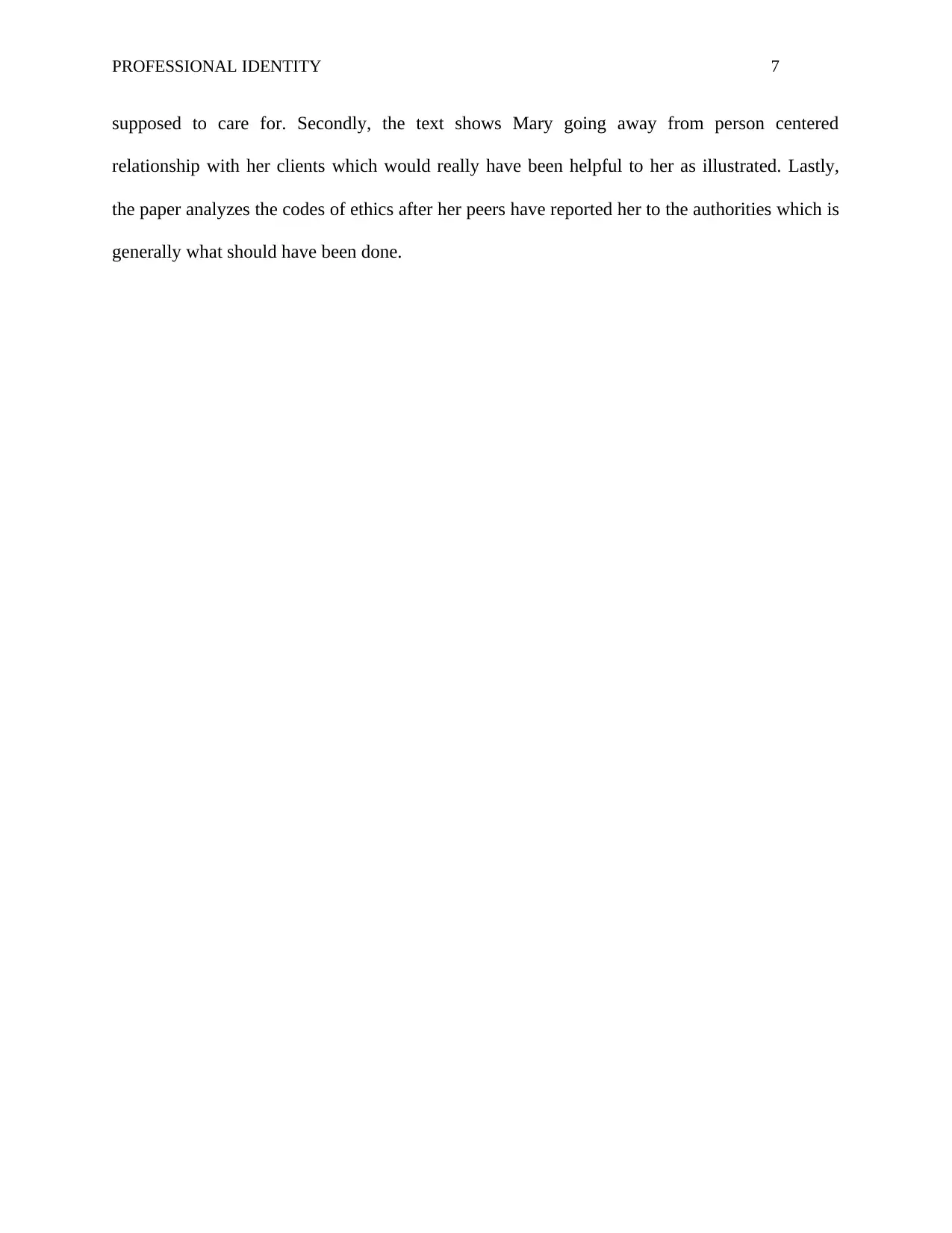
PROFESSIONAL IDENTITY 7
supposed to care for. Secondly, the text shows Mary going away from person centered
relationship with her clients which would really have been helpful to her as illustrated. Lastly,
the paper analyzes the codes of ethics after her peers have reported her to the authorities which is
generally what should have been done.
supposed to care for. Secondly, the text shows Mary going away from person centered
relationship with her clients which would really have been helpful to her as illustrated. Lastly,
the paper analyzes the codes of ethics after her peers have reported her to the authorities which is
generally what should have been done.
Paraphrase This Document
Need a fresh take? Get an instant paraphrase of this document with our AI Paraphraser
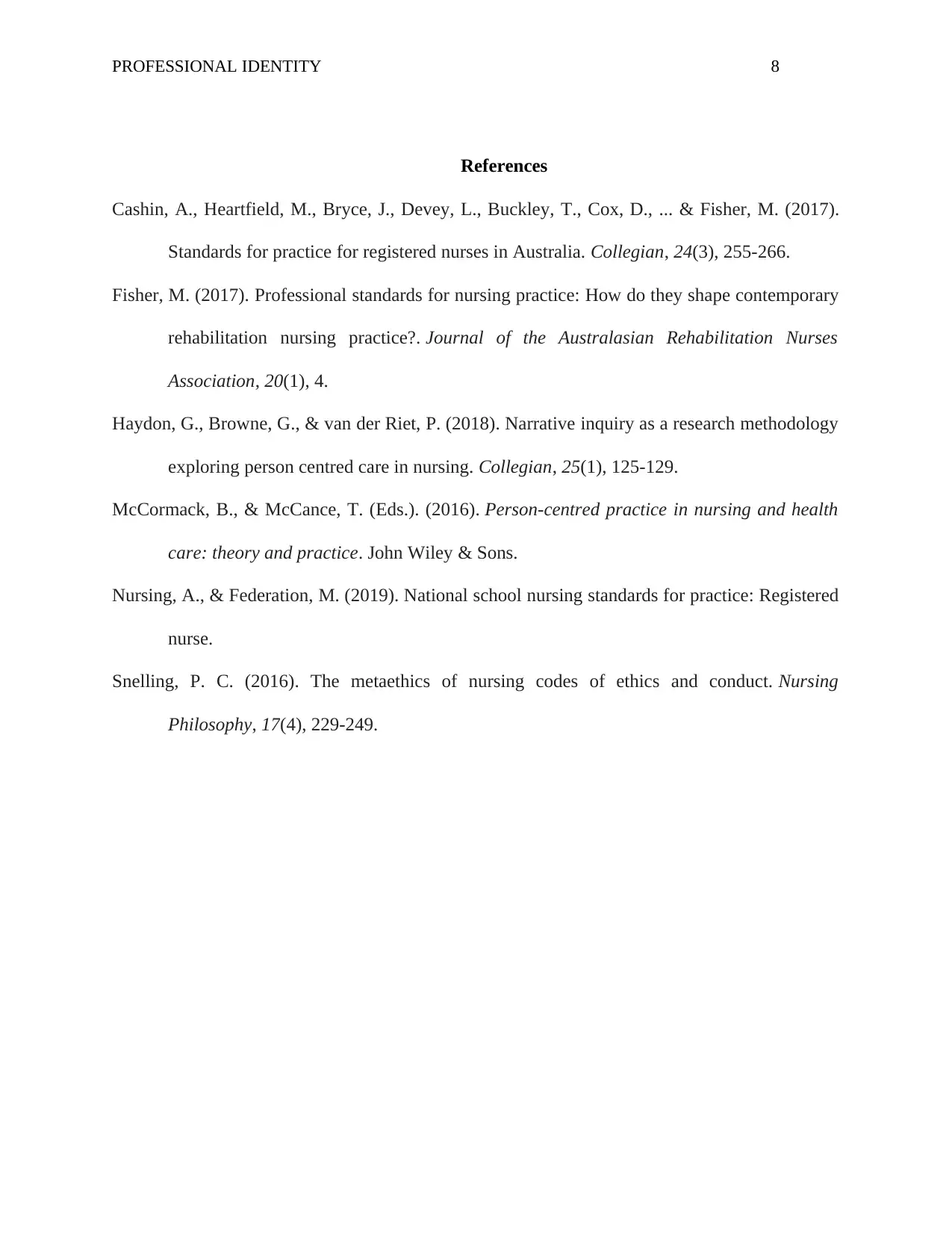
PROFESSIONAL IDENTITY 8
References
Cashin, A., Heartfield, M., Bryce, J., Devey, L., Buckley, T., Cox, D., ... & Fisher, M. (2017).
Standards for practice for registered nurses in Australia. Collegian, 24(3), 255-266.
Fisher, M. (2017). Professional standards for nursing practice: How do they shape contemporary
rehabilitation nursing practice?. Journal of the Australasian Rehabilitation Nurses
Association, 20(1), 4.
Haydon, G., Browne, G., & van der Riet, P. (2018). Narrative inquiry as a research methodology
exploring person centred care in nursing. Collegian, 25(1), 125-129.
McCormack, B., & McCance, T. (Eds.). (2016). Person-centred practice in nursing and health
care: theory and practice. John Wiley & Sons.
Nursing, A., & Federation, M. (2019). National school nursing standards for practice: Registered
nurse.
Snelling, P. C. (2016). The metaethics of nursing codes of ethics and conduct. Nursing
Philosophy, 17(4), 229-249.
References
Cashin, A., Heartfield, M., Bryce, J., Devey, L., Buckley, T., Cox, D., ... & Fisher, M. (2017).
Standards for practice for registered nurses in Australia. Collegian, 24(3), 255-266.
Fisher, M. (2017). Professional standards for nursing practice: How do they shape contemporary
rehabilitation nursing practice?. Journal of the Australasian Rehabilitation Nurses
Association, 20(1), 4.
Haydon, G., Browne, G., & van der Riet, P. (2018). Narrative inquiry as a research methodology
exploring person centred care in nursing. Collegian, 25(1), 125-129.
McCormack, B., & McCance, T. (Eds.). (2016). Person-centred practice in nursing and health
care: theory and practice. John Wiley & Sons.
Nursing, A., & Federation, M. (2019). National school nursing standards for practice: Registered
nurse.
Snelling, P. C. (2016). The metaethics of nursing codes of ethics and conduct. Nursing
Philosophy, 17(4), 229-249.
1 out of 8
Related Documents
Your All-in-One AI-Powered Toolkit for Academic Success.
+13062052269
info@desklib.com
Available 24*7 on WhatsApp / Email
![[object Object]](/_next/static/media/star-bottom.7253800d.svg)
Unlock your academic potential
© 2024 | Zucol Services PVT LTD | All rights reserved.




